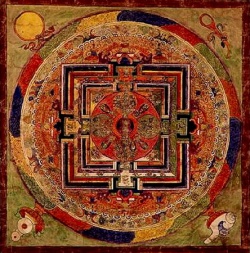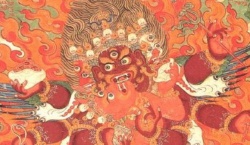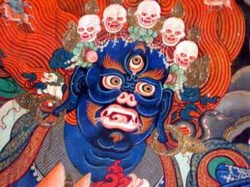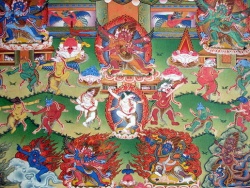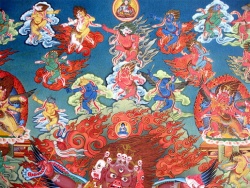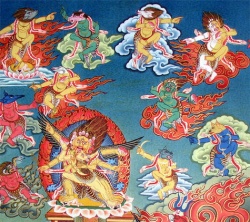Bardo Teachings of Jamgon Kongtrul Rinpoche
In one of his final teachings the Buddha introduced the idea of tathagatagarbha, the buddha essence within every sentient being. The teachings make it very clear that tathagatagarbha pervades all beings equally in quantity as well as quality. This primordial essence is never defiled, but it becomes obscured when an individual engages in negative activity and thus accumulates negative karma that prevents him or her from recognizing tathagatagarbha. Such individuals are called sentient beings, while those who recognize buddha essence are called enlightened
beings. That recognition is the only distinction between sentient and enlightened beings, for both have an equal quantity and quality of tathagatagarbha. The real purpose of practicing the dharma is to realize the manifestation of buddha essence that we now only glimpse.
To help us recognize buddha essence within ourselves, the Buddha gave an unimaginable number of teachings, and the bardo teaching is one of the most profound. This teaching is extraordinarily important for our present-day world, because today we live with widespread conditions of distraction that weaken our ability to concentrate fully upon whatever practice we are engaged in.
The bardo is the intermediate stage between the beginning and the end of anything. The "in-betweenness" is itself the bardo. Therefore we must also understand that there is nothing in all outer and inner phenomena that is not included within the bardo. For example, one bardo is from the moment you are conceived to the moment you are born. Another is from birth until you begin to
crawl, and another until you are sent to school, and then another until you finish school. The period between falling asleep and awaking the next day is a bardo, and when you dream, the time from the beginning to the end of a nightmare is another bardo. The moment you start eating breakfast until you finish breakfast—that, too, is one bardo! All of these bardos are classified within the bardo of birth and death.
Everything is subject to the bardo—everything between the first and second moment, between one day and another. In short, there is nothing that is permanent or solid and concrete. Everything is subject to change. All inner and outer phenomena are within the bardo, and through knowledge of the intermediate state we can come to understand the non-substantiality and non-concreteness of both samsara and nirvana. Although there are many classifications of bardo, here we will be discussing the bardo state from the moment we separate our consciousness from the physical body until we experience rebirth. There are many further classifications within this experience.
The intermediate state between death and rebirth is an excellent time to recognize tathagatagarbha. While we are alive, it takes some effort to experience our true nature, but during the bardo state between death and rebirth
we experience it naturally. The only question is whether we recognize it. It is not something we need to search for; in fact, buddha essence is so close that we fail to recognize it. If we have trained ourselves in daily life, then there is a greater chance that we will become liberated at the moment of death, when buddha essence naturally manifests.
That is why the bardo state presents an extraordinary method of practice.
In general, the bardo between death and rebirth is presented in three forms known as the bardo of the moment of death, the bardo of dharmata (buddha nature), and the bardo of existence or possibility. The bardo of the moment of death can be explained by understanding that our physical bodies are a gathering of the four elements: earth, fire, and
air. In the bardo of the moment of death—the period of betweenness known as the intermediate state—these four elements dissolve into one another. This is important to understand because, as an individual goes through different experiences at the
moment of death, unless we understand what is happening, we will panic. Once we understand that these events are simply the result of elements dissolving into elements, then we can experience them without fear. Only with fearlessness can we maintain mindfulness and awareness free from distraction.
THE FIRST ELEMENT TO DISSOLVE is earthh dissolves into water. The external sign that this is happening is that the individual who is experiencing death becomes physically weak and is unable to move. The internal sign is that awareness becomes smoky, like perception through fog. This is an experience of vagueness that cannot be pinpointed. An
individual who is not open, and has not been instructed in the meaning of these signs, may panic at this point. We need to understand that vagueness and smoky awareness are simply the experience of earth dissolving into water, and that our mind or consciousness has not changed at all.
The second dissolving stage is when the water element dissolves into the fire element. The outer signs of this are that all the openings of the body—mouth, nose, and so forth—dry up. The inner sign is that the individual's consciousness perceives experiences as if they were mirages, and moving images as dreamlike.
Next, the fire element dissolves into air. Outwardly, the individual loses body warmth. Inwardly, awareness becomes like a flame in the wind. There is a flame, but it is unstable because it is constantly moving.
Finally the air element dissolves into the consciousness. The external sign of this is that we can exhale the breath but can no longer inhale. At this time our consciousness shines like a lamp that is no longer disturbed by wind.
These four stages begin the dissolving stage of the elements at the time of death. After these stages, three additional phases occur: appearance, expansion, and attainment. During these experiences, all the familiar emotions of our daily life dissolve.
In the appearance experience, the outer sign is that everything becomes whitish, and inwardly our consciousness becomes dull. In this stage, aggression and anger dissolve.
Next is the experience known as expanding or increasing. Outwardly, we perceive everything in reddish hues. Our inner awareness could be compared to seeing fireflies at night: we can see flickers of light, but not a constant gleam. At that time, the conflicting emotion of attachment dissolves.
The third of these experiences is known as attainment. During this time, our outer experience is of darkness, a sort of blackout. Inner awareness, here, is like a candle inside a vase. Because the candle is inside the vase, it is able to shine clearly. During this time the conflicting emotion of ignorance is dissolving.
These three dissolving experiences—appearance, expansion, and attainment—also occur in daily life. Every relative perception is an appearance. When we grasp or cling to this appearance, it becomes magnified, and that is expansion. Whatever comes about from the expansion of an appearance is attainment.
Following the experiences of appearance, expansion, and attainment at the time of death, the union of the father and mother energy takes place. The father energy is referred to as a white dot or tigle, and the mother energy as a red
tigle. The mother energy ascends from the bottom, the father energy descends from the top, and they unite at the central location. After the union of these two energies, consciousness leaves the body. The sign that consciousness is exiting is that we experience something like a blackout.
This is the moment when the clear light may be experienced. If someone is familiar with dharma practice, then he or she actually experiences the essential nature of mind—clarity and emptiness free from birth, death, and location. If we
recognize the clear light at the moment of death, then immediately, at that very instant, we experience liberation in the dharmakaya aspect.
Although everyone experiences the natural state in the bardo, those who do not know what to expect cannot recognize it. We must practice during our lifetime to gain the experience that will help us at the moment of death.
The reason we are unable to experience the natural state while we are alive is that too many conditions distract us. The bardo state presents a great opportunity for liberation because at the moment of death, whether you are a practitioner or a
nonpractitioner, or are virtuous or nonvirtuous, you will experience the true nature of your mind. In the bardo, there are not as many distractions as in your samsaric life, so you will experience the clear light naturally. This is a tremendous opportunity, but even when you experience it directly, you may fail to recognize it because you have put so much
effort into your daily life. There are practices we can do at the moment of death. The spiritual master can also introduce a dying person to the bardo in such a way that he or she can recognize the clear light when it occurs.
If, during your lifetime, your meditation was based on a spiritual teacher's instruction on the nature of mind, then, when you experience the clear light, you will recognize it as the nature of the mind that was described by your
teacher. This matching of an experience in meditation with the clear light at death is known as the meeting of the mother and child. Of course, if you practice hard enough, you can achieve enlightenment in this lifetime, and that is the best. However, if that does not happen, there is a possibility to do so after death.
When someone recognizes the clear light of luminosity at the moment of death, when the mother and child meet, that person stays in the meditative state. Some rest in the meditative state because they recognize the clear light in the bardo
and have the ability to unite with it. There are others who rest in the natural state at the moment of death because of the power that they have already gained through shimata meditation. Being able to maintain this state at the time of death is a sign of realization, and it is all based on the strength and diligence of an individual's practice.
Adapted from a talk entitled Death and Dying: Buddha Essence and the Intermediate State and reprinted with permission from Densal.
